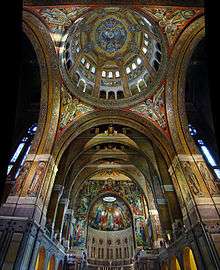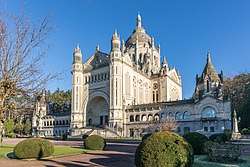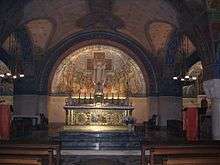Basilica of Sainte-Thérèse, Lisieux
The Basilica of Sainte-Thérèse of Lisieux (French: Basilique Sainte-Thérèse de Lisieux) is a Roman Catholic church and minor basilica dedicated to Saint Thérèse of Lisieux. Located in Lisieux, France, the large basilica can accommodate 4,000 people, and, with more than two million visitors a year, is the second largest pilgrimage site in France, after Lourdes.[2] Pope John Paul II visited the Basilica on 2 June 1980.[3]

| Basilica of Sainte-Thérèse of Lisieux Basilique Sainte-Thérèse de Lisieux (in French) | |
|---|---|
 Basilica of Sainte-Thérèse in Lisieux | |
| Religion | |
| Affiliation | Roman Catholic |
| Ecclesiastical or organizational status | Minor basilica |
| Year consecrated | 1951 |
| Location | |
| Location | Lisieux, France |
| Geographic coordinates | 49°8′22.56″N 0°14′11.04″E |
| Architecture | |
| Architect(s) | Louis-Marie Cordonnier, Louis-Stanislas Cordonnier, Louis Cordonnier |
| Type | Church |
| Style | Neo-Byzantine |
| Groundbreaking | 1929 |
| Completed | 1954 |
| Specifications | |
| Capacity | 4000 |
| Length | 105 metres (344 ft) |
| Width | 65 metres (213 ft) |
| Height (max) | 90 metres (300 ft)[1] |
| Website | |
| http://www.therese-de-lisieux.catholique.fr | |
History
Saint Thérèse of Lisieux was beatified in 1923 and canonised in 1925. Bishop of Bayeux and Lisieux, Bishop Thomas-Paul-Henri Lemonnier, decided to build a large basilica dedicated to her in the city where she lived and died.[4] The project received the full support of Pope Pius XI who had placed his pontificate under the sign of Saint Thérèse. Construction started in 1929 and completed in 1954. The basilica is located on a hill at the southeastern edge of the city. It was funded entirely by donations and special contributions from several countries from around the world, based on strong devotions to Saint Thérèse. The basilica thus contains 18 minor altars offered by different nations to Saint Thérèse.
The basilica was blessed on 11 July 1937, by the papal legate Eugenio Cardinal Pacelli (the future Pope Pius XII). Works stopped for some time due to the Second World War, but then resumed and the basilica was completed in 1954. The basic structure, which was completed before the war, suffered little damage during the bombing, which destroyed two-thirds of Lisieux. On 11 July 1951, the basilica was consecrated by Most Reverend, the Archbishop of Rouen Joseph-Marie Martin, with the Papal Legate, Maurice Cardinal Feltin.[1]
Interior
The construction was supervised by three architects from father to son, Cordonnier – Louis Marie, and his son Louis-Stanislas Cordonnier and his grandson Louis Cordonnier. The Roman-Byzantine style of the basilica was inspired by the Sacred Heart Basilica, Paris. The building is in the shape of a Latin cross, with nave, choir and transept. The crossing is surmounted by an imposing dome. The internal volume is all in one piece, without collateral or ambulatory aisles. Due to the absence of columns, all who attend mass have an unobstructed view. Much of the basilica interior is covered with mosaics.
Crypt

Completed in 1932, the crypt evokes the secret of the spiritual life of Saint Thérèse.[5] It is decorated with marble and mosaics representing certain scenes in the life of Saint Thérèse: baptism, first communion, miraculous healing, commitment to religious life, death.
In the summer of 1944, the townspeople who remained in Lisieux took refuge in the crypt of the basilica. The Carmelites of Lisieux, including Saint Thérèse's two surviving sisters, lived in the crypt of the basilica that summer.
Exterior
Built in the 1960s, the bell tower is separated from the main building and situated on the square. It was never completely finished, the priority has been given to charity. It contains 51 bells, or 6 to 45 and fly for carillon (all color). It gives concerts twice a day. The bells were donated by Belgium and Holland in the ex-voto to Saint Thérèse.
Way of the cross
The area east of the apse houses a Way of the Cross and tombs which held the parents of Saint Thérèse, Saints Louis Martin and Marie-Azélie Guérin from 1958 through 2008. The causes for their beatification were introduced in 1957.[6] For the first time in the history of the Church, the two causes were united into one by Pope Paul VI. Pope John Paul II declared them venerable in 1994 and Cardinal Saraiva Martins, Papal Legate, announced their beatification in the Basilica of Saint Thérèse on Mission Sunday, 19 October 2008.[7] They were canonized by Pope Francis on October 18th, 2015.[8]
Built in 2000, the chapel of worship is a place for silent prayer. It can be entered through the Crypt. It was offered by the Irish ex-voto to Saint Thérèse.
Notes
- Fafchamps, Laurence. "The Basilica". Sanctuaire de Lisieux. Retrieved 26 December 2018.
- "Lisieux, France". National Shrine of St. Therese. Retrieved 26 December 2018.
- "Pope John Paul II visits Lisieux, June 2, 1980". Saint Therese of Lisieux. Retrieved 26 December 2018.
- "Bishop Thomas-Paul-Henri Lemonnier". Catholic-Hierarchy.org. David M. Cheney. Retrieved 21 January 2015.
- "Religion: Little Flower's Basilica". Time. 11 July 1932. Retrieved 19 December 2015.
- "Blessed Louis and Zélie Martin, the Parents of Saint Thérèse of Lisieux". Saint Thérèse of Lisieux. Retrieved 19 December 2015.
- "Beatification of Louis and Zelie Martin". Saint Therese of Lisieux. Retrieved 26 December 2018.
- Ieraci, Laura (29 June 2015). "St. Therese's parents to be first married couple canonized together". National Catholic Reporter. Catholic News Service. Retrieved 26 December 2018.
References
- Fabrice Maze, The Basilica of St. Therese of Lisieux, PubliAlp, Grenoble, ISBN 2-9522339-0-X
- Jean-Daniel Jolly Monge, The Mystery of Lisieux, Office Central de Lisieux, Lisieux, 2001. ISBN 2-9517460-0-8
- How to become a saint – the story of Saint Therese of Lisieux
| Wikimedia Commons has media related to Basilique Sainte-Thérèse de Lisieux. |